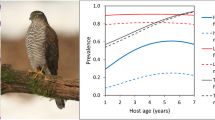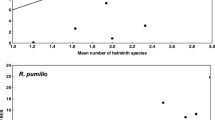Abstract
We explored patterns of infection of three apicomplexan blood parasites with different transmission mechanisms in 46 social groups across seven populations of the Australian lizard, Egernia stokesii. There was higher aggregation of infections within social groups for Hemolivia, transmitted by ticks, and Schellackia, either tick-transmitted or directly transmitted from mother to offspring, than for Plasmodium, with more mobile dipteran vectors. Prevalence was not related to group size, proximity to other groups or spatial overlap with adjacent groups for any of the parasites. However, for Hemolivia, groups with higher levels of relatedness among adults had higher parasite prevalence. Living in social groups leads to higher risk of infection for parasites with low transmission mobility. An unanswered question is why so few lizard species tolerate these risks to form stable social aggregations.





Similar content being viewed by others
References
Alexander RD (1974) The evolution of social behaviour. Ann Rev Ecolog Syst 5:325–383
Altizer S, Nunn CL, Thrall PH, Gittleman JL, Antonovics J, Cunningham AA, Dobson AP, Ezenwa V, Jones KE, Pedersen AB, Poss M, Pulliam JRC (2003) Social organization and parasite risk in mammals: integrating theory and empirical studies. Ann Rev Ecolog Syst 34:517–547
Arneberg P (2001) An ecological law and its macroecological consequences as revealed by studies of relationships between host densities and parasite prevalence. Ecography 24:352–358
Boulinier T, Ives AR, Danchin E (1996) Measuring aggregation of parasites at different host population levels. Parasitology 112:581–587
Brown C, Brown MB (1986) Ectoparasitism as a cost of coloniality in cliff swallows (Hirundo pyrrhonota). Ecology 67:1206–1218
Bull CM (2000) Monogamy in lizards. Behav Processes 51:7–20
Bull CM, Griffin CL, Lanham EJ, Johnston GR (2000) Recognition of pheromones from group members in a gregarious lizard, Egernia stokesii. J Herpetol 34:92–99
Chapple DG (2003) Ecology, life-history, and behavior in the Australian scincid genus Egernia, with comments on the evolution of complex sociality in lizards. Herpetol Monogr 17:145–180
Cogger HG (1994) Reptiles and amphibians of Australia. Reed, Chatswood, NSW
Cooper SJB, Bull CM, Gardner MG (1997) Characterization of microsatellite loci from the socially monogamous lizard Tiliqua rugosa using a PCR-based isolation technique. Mol Ecol 6:793–795
Cote IM, Poulin R (1995) Parasitism and group size in social animals: a meta-analysis. Behav Ecol 6:159–165
Duffield GA, Bull CM (1996) Host location by larvae of the reptile tick Amblyomma vikirri (Acari: Ixodidae). Exp Appl Acarol 20:575–582
Duffield GA, Bull CM (2002a) Stable social aggregations in an Australian lizard, Egernia stokesii. Naturwissenschaften 89:424–427
Duffield GA, Bull CM (2002b) Egernia stokesii (gidgee skink). Opportunistic dispersal. Herpetol Rev 33:204–205
Fox SF, McCoy JK, Baird TA (2003) Lizard social behavior. The Johns Hopkins University Press, Baltimore, MD, 438 pp
Freeland WJ (1979) Primate social groups as biological islands. Ecology 60:719–728
Gardner MG (2000) A genetic analysis of sociality in the Australian group living lizard Egernia stokesii. Ph.D. thesis, Flinders University of South Australia, Adelaide
Gardner MG, Cooper SJB, Bull CM, Grant WN (1999) Isolation of microsatellite loci from a social lizard, Egernia stokesii, using a modified enrichment procedure. J Hered 90:301–304
Gardner MG, Bull CM, Cooper SJB, Duffield GA (2001) Genetic evidence for a family structure in stable social aggregations of the Australian lizard Egernia stokesii. Mol Ecol 10:175–183
Goodnight KF, Queller DC (1998) RELATEDNESS 5.08. http://www.gsoftnet.us/GSoft.html
Jokela J, Schmid-Hempel P, Rigby MC (2000) Dr. Pangloss restrained by the Red Queen—steps towards a unified defence theory. Oikos 89:267–274
Kaltz O, Shykoff JA (1998) Local adaptation in host–parasite systems. Heredity 81:361–370
Keirans JE, Bull CM, Duffield GA (1996) Amblyomma vikirri n. sp. (Acari: Ixodida: Ixodidae), a parasite of the gidgee skink Egernia stokesii (Reptilia: Scincidae) from South Australia. Syst Parasitol 34:1–9
Kenward RE, South AB, Walls SS (2003) Ranges6: for the analysis of tracking and location data. Anatrack, Wareham, UK
Lanham EJ, Bull CM (2000) Maternal care and infanticide in the Australian skink, Egernia stokesii. Herpetol Rev 31:151–152
Liersch S, Schmid-Hempel P (1998) Genetic variation within social insect colonies reduces parasite load. Proc R Soc Lond B Biol Sci 265:221–225
McCoy KD, Boulinier T, Chardine JW, Danchin E, Michalakis Y (1999) Dispersal and distribution of the tick Ixodes uriae within and among seabird host populations: the need for a population genetic approach. J Parasitol 85:196–202
McCoy KD, Tirard C, Michalakis Y (2003) Spatial genetic structure of the ectoparasite Ixodes uriae within breeding cliffs of its colonial seabird host. Heredity 91:422–429
Moller AP, Dufva R, Allander K (1993) Parasites and the evolution of host social behavior. Adv Study Behav 22:65–102
Moller AP, Merino S, Brown CR, Robertson RJ (2001) Immune defence and host sociality: a comparative study of swallows and martins. Am Nat 158:136–145
Mooring MS, Hart BL (1992) Animal grouping for protection from parasites: selfish herd and encounter–dilution effects. Behaviour 123:173–193
Petney TN, Andrews RH, Bull CM (1983) Movement and host finding by unfed nymphs of two Australian reptile ticks. Aust J Zool 31:717–721
Poiani A (1992) Ectoparasitism as a possible cost of social life: a comparative analysis using Australian passerines (Passeriformes). Oecologia 92:429–441
Poulin R (1999) Parasitism and shoal size in juvenile sticklebacks: conflicting selection pressures from different ectoparasites? Ethology 105:959–968
Queller DC, Goodnight KF (1989) Estimating relatedness using genetic markers. Evolution 43:258–275
Ranta E (1992) Gregariousness versus solitude: another look at parasite faunal richness in Canadian freshwater fishes. Oecologia 89:150–152
Raudenbush S, Bryk A, Congdon R (2004) HLM 6: hierarchical linear and non-linear modelling. Scientific Software International (SSI), Lincolnwood, IL
Raymond M, Rousset F (1995) GENEPOP (version 1.2): population genetics software for exact tests and ecumenicism. J Hered 86:248–249
Ross KG (2001) Molecular ecology of social behaviour: analyses of breeding systems and genetic structure. Mol Ecol 10:265–284
Schmid-Hempel P (1994) Infection and colony variability in social insects. Philos Trans R Soc Lond B Biol Sci 346:313–321
Seger J, Hamilton WD (1988) Parasites and sex. In: Michod RE, Levin BR (eds) The evolution of sex: an examination of current ideas. Sinauer, Massachusetts, pp 176–193
Shykoff JA, Schmid-Hempel P (1991a) Genetic relatedness and eusociality: parasite-mediated selection on the genetic composition of groups. Behav Ecol Sociobiol 28:371–376
Shykoff JA, Schmid-Hempel P (1991b) Parasites and the advantage of genetic variability within social insect colonies. Proc R Soc Lond B Biol Sci 243:55–58
Smallridge C, Paperna I (1997) The tick-transmitted Haemogregarinid of the Australian sleepy lizard Tiliqua rugosa belongs to the genus Hemolivia. Parasite 4:359–363
Smallridge C, Bull CM (1999) Transmission of the blood parasite Hemolivia mariae between its lizard and tick hosts. Parasitol Res 85:858–863
Smallridge C, Bull CM (2000) Prevalence and intensity of the blood parasite Hemolivia mariae in a field population of the skink Tiliqua rugosa. Parasitol Res 86:655–660
Smith L, Burgoyne L (2004) Collecting, archiving and processing DNA from wildlife samples using FTA(R) databasing paper. BMC Ecol 4:4
Stein J (1999) An ecological study of the blood parasites of E. stokesii. Ph.D. thesis, Flinders University of South Australia, Adelaide
Stein J, Dyce AL (2002) Field observations on the phlebotomine sand fly Australophelbotomus mackerrasi Lewis and Dyce feeding on the gidgee skink Egernia stokesii Gray. Parasitol Res 88:278–279
Stow AJ (2002) Microsatellite loci from the Cunningham’s skink (Egernia cunninghami). Mol Ecol Notes 2:256–257
Telford SR (1984) Haemoparasites of reptiles. In: Hoff GL, Frye FL, Jacobsen ER (eds) Diseases of amphibians and reptiles. Plenum, New York
Acknowledgements
This research was funded by grants from the Australian Research Council. Dr. Cathy Smallridge helped with the identification of the blood parasites, and Phil Mayes, Aaron Fenner and Gary Hallas also helped with the research. Kylie Lange provided advice on statistical analysis. The study was conducted according to the guidelines of the Flinders University Animal Welfare Committee in compliance with the Australian Code of Practice for the use of animals for scientific purposes.
Author information
Authors and Affiliations
Corresponding author
Rights and permissions
About this article
Cite this article
Godfrey, S.S., Bull, C.M., Murray, K. et al. Transmission mode and distribution of parasites among groups of the social lizard Egernia stokesii . Parasitol Res 99, 223–230 (2006). https://doi.org/10.1007/s00436-005-0120-9
Received:
Accepted:
Published:
Issue Date:
DOI: https://doi.org/10.1007/s00436-005-0120-9




